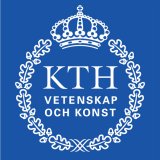
KTH (Kungliga Tekniska Högskolan), Stockholm, Sweden, the largest technical university in Sweden is divided into 9 schools. The Marcus Wallenberg Laboratory for Sound and Vibration Research (MWL) is a division of the Department of Vehicle and Aeronautical Engineering (www.ave.kth.se) and belongs to the School of Engineering Science. MWL as a KTH centre for Technical Acoustics was founded in 1977 and is today one of the larger university centres for Technical Acoustics in Europe with 4 full time professors, 8 senior researchers and 18 PhD students. MWL is offering both a Swedish and an international MSc program in Sound and Vibration graduating 20-25 students per year. The research activities focus on vehicle related applications and can be split into three main areas: Flow Acoustics, Numerical Acoustics and Vibro-acoustics. The approach is a combination of theoretical work leading to numerical models and advanced experimental investigations. The latter is supported by the excellent laboratory facilities at MWL that include all types of acoustic test rooms (anechoic, reverberant, semi-anechoic) and special flow test rigs that can be connected to the rooms. Besides being involved in teaching and research MWL also has a strong industrial network and is involved in two KTH competence centres: KTH-CICERO (www.cicero.kth.se) and KTH-ECO2 (www.eco2vehicledesign.kth.se) related to the sustainable development of future engines and vehicles. In particular the ECO2 centre can be important for the present project. KTH-MWL has a large experience in participating in EC-projects, some recent examples are: ARTEMIS, DUCAT, ENABLE, FLODAC, INMAR, NABUCCO, NORMA, PROBAND, RATIN, SEFA, SILENCE.
Specific skills for ECOQUEST
In the present project it will be the Flow Acoustics group at MWL who is involved. This group led by Prof. Mats Åbom consists of four seniors and presently has 6 PhD students. For the planned work in ECOQUEST a new PhD student will be recruited. Two of the main research areas of the Flow Acoustic group are sound in ducts and source characterization of fans. The group has published the first papers on the use of acoustics multi-port models to characterize ducted fans. Another area of expertise is experimental techniques for flow ducts. The Flow Acoustic group is also part of the team of excellent researchers who was given a so called Linneus Grant from the Swedish Science foundation in 2007. This grant forms the basis for the KTH-Linne´ FLOW centre where the Flow Acoustic group is a partner (www.flow.kth.se). Via the Linne´FLOW centre the Flow Acoustic group have access to both CFD competence and also experimental facilities and equipment for advanced fluid mechanics experiments (e.g. PIV). This will be important for the present work and it is planned that Prof. Laszlo Fuchs CFD expert in the Linne FLOW centre will support the work concerning modelling of the truck cooling fan (Task 3.4). The Flow Acoustic group has also been involved in work on fan noise in a number of earlier EC-projects (FLODAC, NABUCCO, SILENCE) and the results and experience from these earlier projects will be a good basis for the planned efforts in ECOQUEST.
Key personnel
Prof. Mats Åbom: PhD in Engineering Acoustics, Head of MWL. Research focus aero-acoustics of interior flows and fluid machinery noise. Also other persons in Flow Acoustic group at MWL such as Dr. Hans Boden and Dr. Susann Boij will contribute to the work. It also planned that some staff from the KTH Linné FLOW centre in particular Prof. Laszlo Fuchs: PhD in Gasdynamics and CFD expert will be involved. The persons mentioned above will supervise the work which will partly be carried out by a new PhD student recruited for the project.
Expected outcome/exploitable results and ’action plan' to get results in use
KTH expects advanced acoustic prediction tools for systems
with flow and new design rules for passive noise absorbers. The
mathematical model for sound absorption by microperforated and
cooling matrix type surfaces is an important outcome,
subsequently being used directly within ECOOQUEST but also
being published and peer reviewed within the scientific
community.


